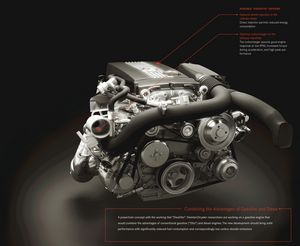.
Mercedes-Benz DiesOtto

| |
| Mercedes-Benz DiesOtto | |
|---|---|
| Engine | |
| Manufacturer | Mercedes-Benz |
| aka | "DiesOtto" |
| Type | Gasoline |
| Production/Introduction | |
| Status | Concept |
| Displacement | 1.8 litre (1800cc) |
| Aspiration | Turbocharged |
| Configuration | |
| Cylinders | Four (4) |
| Bore | |
| Stroke | |
| Displacement | |
| Length | |
| Diameter | |
| Width | |
| Height | |
| Dry Weight | |
| Output | 238 hp (175 kW) @ N/A rpm 400 Nm of torque @ N/A rpm |
| Fuel Consumption | 44 mpg (5.3 litres/100km) |
| Chief Engineer | |
The Mercedes-Benz DiesOtto is an experimental (also called concept-engine) automobile engine that is said "to incorporate the benefits of a diesel engine, but runs on regular old unleaded." [1]
Its name is an intended play on words, referring to the Diesel engine, first introduced by German engineer Rudolf Diesel, and the Otto cycle, as a reference to Nicolaus Otto, both being German (even though the paternity of the gasoline engine is still disputed between Nicolaus Otto and Alphonse Beau de Rochas).
Photos
Unique Attributes
The Diesotto is an inline 4 gasoline engine, with a 1.8l displacement. Its peak power is no less than 238 bhp/175 kW (that makes for 132 bhp/l) with a peak torque of 400 Nm (222 Nm/l). However, the revs at which these peake horsepowrer and torque are achieved are not specified[2].
The Diesotto features the following:
- controlled auto ignition, much like that of a Diesel;
- variable valve timing;
- variable geomerty turbocharging;
- variable compression ratio;
- direct gasoline injection.
It is also fitted with a starter alternator to further increase its mileage in town conditions. Its principle of operation is to operate using controlled auto ignition on low demanding conditions (even shutting down the engine altogether at a stop thanks to the starter alternator), and harvest the full benefits of turbocharging and direct injection on high demanding conditions.
It is reported to achieve less than 6l/100km (or more than 47 UK mpg, 40 US mpg) in the body of an S class. However, it is unknown in what conditions this mileage is achieved. Nevertheless, these mileage figures are only bested by the smallest Diesel engines on sale in Europe, and in far smaller cars than the S class.
Criticisms
Please make sure to keep critiques in a third-person point of view. If using criticisms from a reputable automotive source, then please make sure to cite the quote.
Worldwide
If the vehicle is sold in other markets worldwide, then this is the section to mention that information. Also, mention if the <MODEL> goes by another name in these other markets.
Design quirks and oddities
Refer to any pop-culture tidbits about the vehicle in this section.
Awards
List out notable awards that the model has recieved while in production. Boldface the company or orgainization that gives out the award, and Italicize the name of the award.


